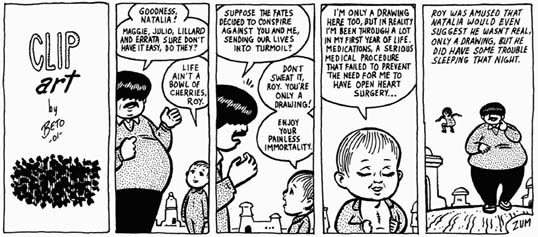

[ MAUKA MAKAI ]
True confessions time -- despite a deep appreciation of, and a genuine love for, the storytelling medium known as comics, for years the only comic I bought regularly was a black-and-white title called "Love and Rockets." Each new issue was an event -- disconnect the phone, mama, turn off the TV, I'm busy tonight!
The work of 2 Hispanic comic
artists produced extraordinary
explosions in American cultureDRAWN & QUARTERED
By Burl Burlingame
bburlingame@starbulletin.comLike any successful work of art, the comic had the ability to immerse you completely in a world that was both fabulist and grounded, done with wit, verve and sheer brilliance.
And it was essentially two for the price of one. "Love and Rockets" is the work of brothers Jaime and Gilbert Hernandez, whose grooves run in different paths. Both, however, are master storytellers, writers and artists. They are not widely known because, frankly, they are Hispanic. But their work over the last decade and a half has produced some of the most extraordinary explosions in modern American culture.

Gilbert, or "Beto," uses a loose, clotty brush to outline his characters. He works from the edges in. Gilbert's fictional canvas, however, is gigantic, encompassing dozens -- maybe hundreds -- of sharply defined characters inhabiting a kind of F. Scott Fitzgerald/Graham Greene backwater known as Palomar, vaguely South American, where ancient Indian deities lie in ruins and nature is forever encroaching, and white folks from "the north" stir things up. Sex is often presented graphically but never lewdly, and generally the characters are oblivious in its grip.Beto's dreamlike stories can be surreal and expressionistic while also seeming wholly natural; it seems a Hispanic literary characteristic, very Marquez. Jaime, on the other hand, is edgy and flip, and his interests aren't societal as much as they are interpersonal. Jaime's best work deals with the problems of missed connections and loneliness, and takes place in a sort of Los Angeles barrio nicknamed Hoppers 13, populated by punks, rockers, wrestling stars and working girls.
His artwork is in contrast to his romantic nature. It's bright and clean and cartoony, almost "Archie"-like, and his use of chiaroscuro lighting is masterful.

Also in direct opposition to the male-dominated world of fantasy comics, the characters of both Hernandez brothers are predominantly strong, erratic, fully formed women who look like real people."Love and Rockets" reached 50 issues, and the brothers dropped the title, spreading themselves thin in other lines. Luckily, the "Love and Rockets" back issues have been continually in print in collected works.
Recently, "Love and Rockets" has returned, and it's reason to celebrate. Although printed by Fantagraphics, you're hard-pressed to find much about the publisher inside or on the cover. Each volume is extremely high-quality in its presentation, from the screaming black-and-white printing to the stiff paper stock. It's a first-class effort all the way. Maybe now the title will get the attention it deserves.
Click for online
calendars and events.